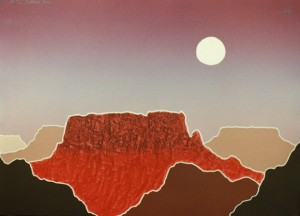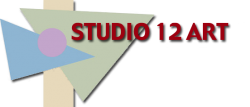

by Carol Hoffnagle and Peter Keefer
A collagraph is a print from a collage; a relief print is a print from a flat surface. Our hand-pulled prints are produced by the collagraph and/or relief print process.
The printing plate we use is 1/4 inch masonite which is drawn on and then cut into separate pieces. To obtain the smooth surface necessary for inking these pieces, gesso is used. Four thin coats are applied, then sanded, then four more coats and a final sanding.
During the actual printing process, a great deal of time is spent inking each separate piece; sometimes there are as many as 50 pieces. The blends are achieved by placing 2-5 connected colors out on a flat surface. Then a roller is used to blend the colors by moving the roller to the left and right, as well as back and forth. The ink is next transferred to the individual pieces. Once all the pieces are inked, they are placed on the bed of the etching press, like a big jigsaw puzzle. The paper is placed on top, and is run through the press, where the ink is transferred to the paper. All this has to be done again to produce additional prints of the same image.
Some of the prints also employ collagraphic areas. These are pieces where the surface of the plate is built up using textures, glues, acrylics and lacquers. Ink is then spread on the plate and carefully wiped off, much the way an etching plate is inked and wiped. The difference is that the etching has a surface that is bitten into, and the collagraph has a surface that is built up. The ink remains in the cracks and crevasses where the pressure of the printing process transfers that ink to the paper.
These areas, together with the relief work, result in an original print with the subtlety of airbrush combined with the dynamic imagery produced by this technique.
